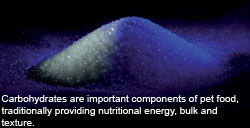A new carbohydrate approach for pets

Similarly to humans an increasing number of pets develop diabetes in conjunction with becoming overweight and obese. For many, along with obesity comes a concomitant rise in associated diseases of many vital organs, together with increases in inflammatory conditions such as arthritis. Dietary assistance for the blood glucose andmetabolic control as well as for weightmanagement of pets is thus of great importance according to Dr. Jörg Bernard and Dr. Gunhild Kozianowski.
By Dr Jörg Bernard and Dr. Gunhild Kozianowski
Not just in the already obese dog or cat, but also in normal weight animals a healthy diet is crucial to maintaining the health and well being of the pet. So far, research on dietary carbohydrates in pet nutrition in order to improve metabolic control in diabetic and/or overweight animals has focused on non-starch polysaccharides and fibres. In this article we describe the properties of a novel low glycemic, low insulinemic sugar syrup* and its potential nutritional role in pet food.
Carbohydrates of interest
Carbohydrates in classical nutrition were roughly distinguished into digestible sugars and (cooked) starches as well as undigestible non-starch polysaccharides or fibres. Today, we know that these classes are heterogeneous and consist of substances with different nutritional potential. For instance among the fibres, feeding particular prebiotics (e.g. inulin) to pets, with their many benefits, has become well established and is now an important component of diet design.
Prebiotics are fermented in the hind gut and – in contrast to other fibres – stimulate a beneficial gut flora. Cooked starches and conventional sugars such as sucrose or glucose are usually rapidly digested and absorbed in the upper gut which triggers a rapid blood glucose response. In contrast, the novel sugar syrup largely consists of slowly digestible sugars, which thus provide a smoother and prolonged blood glucose response. It is manufactured by the enzymic conversion of sucrose into an approximate mixture of 30% isomaltulose (marketed as Palatinose™, hereafter called PAL), 30% trehalulose 30% fructose/glucose/sucrose and 10% isomaltose. The health potential of its slow digestible sugars is promising both for humans and animals and the subject of intensive research, but is as yet, for pet food unexploited.
Nutritional carbohydrate approach
After a meal with rapidly digestible sugars and starches, the released glucose is immediately absorbed leading to a large and rapid rise in the blood glucose level and insulin response. Insulin triggers the glucose removal from the blood into muscle and other tissues.
In diabetic humans and animals the glucose response is elevated over an abnormally long period of time and obese subjects are supposed to be in a transition period of this status called glucose intolerance or insulin resistance. Dietary strategies for prevention as well as treatment thus aim to ameliorate the blood glucose response. This is most important with sedentary humans as well as animals. For this type of pet, low-glycemic meals help to normalise the metabolism and assist in weight management. Lowering the glycemic load of a meal can be achieved by replacing digestible carbohydrates by fibres. Research in pets has shown that high fibre diets improve glycemic control parameters in diabetic dogs and cats as well as improving satiety and weight control (Kimmel et al., 2000; Nelson et al., 1991; Kirk 2006; Bennet et al., 2006; Nelson et al., 2000).
However, this approach will inevitably increase the amounts of fibres for the gut flora, faecal bulk etc. and also reduce the amount of glucose energy which is required for optimum performance of certain organs.
A second strategy is aimed at reducing the glycemic peak by extending the digestion period; this has the benefit of providing the full glucose energy (slow release principle). Such an effect is evident from a prolonged blood glucose response curve as shown for isomaltulose, one principal component of the sugar syrup, compared to sucrose (Figure 1).
As a consequence, low glycemic sugars also have a lower insulin demand, important in modulating insulin resistance, thus moderating metabolic syndrome which is speculated to play an important role in the development of obesity and related metabolic disorders.
Technical properties
Apart from its nutritional properties, this syrup is highly palatable (shown for dogs; see Linaet al., 2002) and has a number of other interesting properties for the pet food manufacturer.
At 65±3% dry matter and pH 4-6, the viscosity of the sugars syrup S at 25 °C lies between 50 and 300 mPa*s. The specific behaviour of the mixtures of palatinose and trehalulose leads to a supersaturated syrup which at
25 °C can be handled without crystallisation for long periods and is microbiologically stable for at least up to 3 months. Figure 2 illustrates the increase of the viscosity of sugars syrup at 65% dry matter for falling temperatures. The solubility curve of this syrup shows quite plainly its supersaturated nature at typical handling temperatures. Palatinose and trehalulose have an effective stabilising effect as antioxidants on feed formulations at low level inclusions (Kowalczyket al., 2008).
Thus, the sugars syrup offers considerable potential to enhance product stability in particular for modern functional diets that contain nutrients which are sensitive to oxygen spoilage such as polyunsaturated fatty acids. Palatinose, trehalulose, glucose and fructose are reducing sugars. Reducing sugars undergo Maillard reactions in particular with amino nitrogen compounds to bring about both colour and flavour enhancement to a food.
Nutritional properties
When starch is cooked during pet food processing, it becomes rapidly digestible for small intestine enzymes. The released glucose is then rapidly absorbed and leads to the rapid rise in blood plasma as described above.
The trehalulose and palatinose in the sugars syrup, however, are just slowly digested by intestinal enzymes and lead to a lower, but sustained rise in plasma glucose.
The data are confirmed for PAL in vivo for several species such as pigs, humans and rodents (Linaet al., 2002) – suggesting a similar digestive physiology to dogs. Due to their similar kinetics, it can be assumed that trehalulose and palatinose behave nutritionally equivalent.
Although the rate of digestion and absorption is slower for the main sugars in the sugars syrup, in vivo data with PAL in rats, pigs and humans have shown that it is virtually complete.
In pigs, this was shown in re-entrant fistulated pigs that received 20% palatinose or sucrose in the diet. Almost all palatinose had disappeared at the end of the ileum similar to sucrose (van Weerdenet al., 1983).
In humans, the complete hydrolysis of PAL in liquid and solid foods was recently confirmed by Holubet al. (2009). More than 95% had disappeared at the end of the ileum and confirmed its good digestibility. The high digestibility is also evidenced by the measured energy value of 14MJ/kg (Paulicks and Roth-Maier, 2005).
Physiological properties
Apparently linked to the slow glucose release, the ingestion of low glycemic PAL has been shown to lead to a higher fat oxidation in humans and animals (Kozianowski 2007; Arai et al., 2007).
Feeding in rats and mice for 2 months led to lower body weight gain as well as lower visceral and liver fat accumulation with a palatinose vs. a control; effects on gene expression of enzymes and signalling factors in fat metabolism were also found in liver and adipose tissue of rats. The findings on body weight and adipose tissue in addition to reduced hyperglycemia and hyperlipidemia were confirmed in Zucker rats, a model for insulin resistance (Arai et al., 2004; Matsuo et al., 2007; Kashimura et al., 2007; Sato et al., 2007). Indications for a favourable effect of palatinose on symptoms of the metabolic syndrome were also found in humans with certain predispositions (Holub et al., 2009; Oizumi et al., 2007).
Summary
Carbohydrates are important components of pet food, traditionally providing nutritional energy, bulk and texture. With increasing knowledge we know meanwhile better to use tailor-made mixes of carbohydrates to meet the challenges in pet food nutrition for prolonged healthy life and well-being of the animals.
The sugars syrup is a mixture of low glycemic sugars that ameliorate and sustain blood glucose energy provision and a corresponding lower insulin demand. For PAL it has been shown in animals that it leads to lower body weight and visceral fat accumulation, too.
The data suggest beneficial nutritional properties of the sugars syrup for all animals which may be affected by metabolic diseases involving fat and carbohydrate metabolism such as obesity and the metabolic syndrome. This could be similarly important for prevention in a normal diet as well as special diets for obese and diabetic cats and dogs.
*Marketed under brand name BeneoCarb S
Source: FeedMix vol 17 nr 4, 2009











